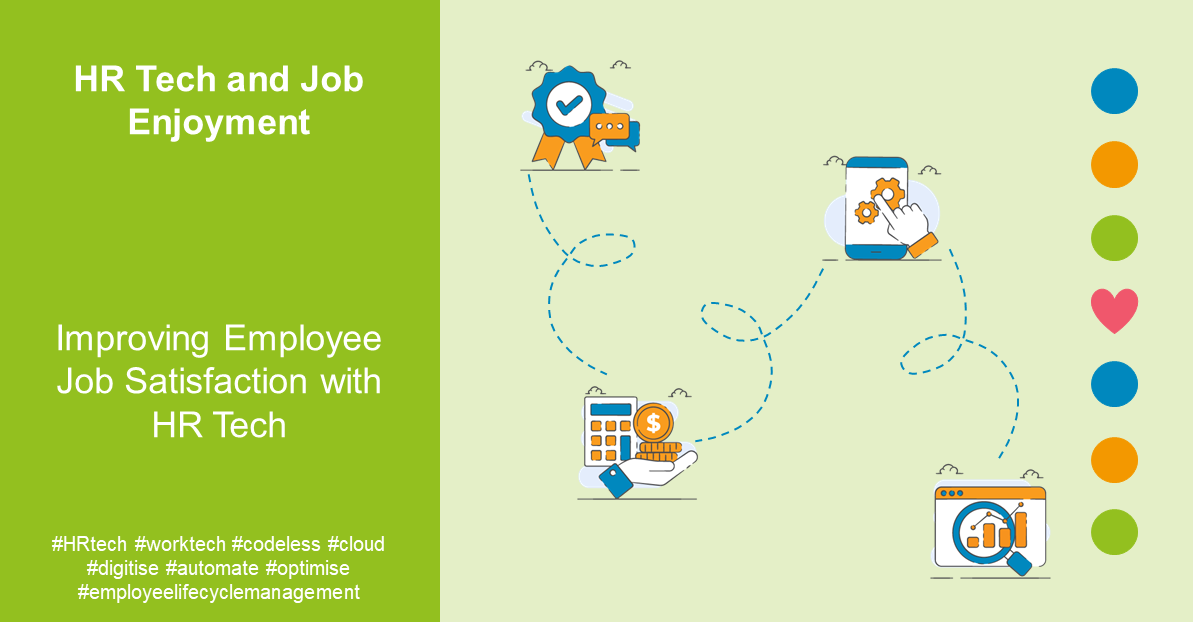Things are changing fast in society, the economy, and business, making it super important for companies to focus on how employees feel at work. Job satisfaction is now just as important as any other business challenge.
In fact, companies that invest in making their employees' job satisfaction better can make 25% more profit than those that don't. There’s no secret – happy employees work better and make customers happier too. ☀️

Lots of companies have used technology to help their employees work together and stay productive while working from home in the past year. They've used technology to create ways for people to talk to each other and feel like they're part of a team, just like they do for customers. That’s why today, HR tech is a powerful solution to boosting employee job satisfaction.
Here's the tricky part: there are so many HR tech options out there that it can be hard to choose the best one for your team. That’s why we’ve written this guide to help you navigate the fast-growing world of HR tech for improving employee job satisfaction. Read on if you want to learn:
|
Let’s dive right in! 👇
What is Job Satisfaction and Why Is It Important?
Job satisfaction is essentially something intangible. It refers to the positive emotional reaction one has while performing their job or being at work. It's crucial to acknowledge that job satisfaction will be entirely different from one employee to the next. In the same work environment and under identical conditions, what makes one employee content with their job might not have the same effect on another.
A few helpful questions to gauge job satisfaction are:
-
Is your organisation committed to the well-being of its employees?
-
Does the workplace provide opportunities for employees to pursue their hobbies?
-
What is the typical time frame between promotions?
-
Do employees feel respected by their colleagues?
-
Is there a culture that encourages open feedback and communication?
-
How does your company approach work-life balance?
-
How do employees evaluate their relationships with their direct supervisors?
-
Does your organisation adhere to equitable and inclusive policies?
-
Are employees able to exercise their creativity within their roles?
-
Do employees feel secure in their positions?
Why Is Assessing Job Satisfaction So Hard
Companies across the world invest hundreds of millions of dollars in evaluating employee satisfaction and engagement.
Yet, workplace stress is at an all-time high globally. A majority of workers claim to be unfulfilled in their jobs. Industries like tech and media are witnessing waves of layoffs. Job-quitting rates have reached their highest in many countries.
Assessing job satisfaction levels can be challenging due to its subjective nature. People perceive job satisfaction differently and assign varying importance to different factors when determining whether they are satisfied or dissatisfied at work.

How Job Satisfaction Affects Employee Performance
Many studies show that making employees happier is a smart move for any business. This is because happy employees usually lead to better long-term success for the company. When employees are satisfied with their jobs, they perform better, which can lead to more profits. Ultimately, happy employees are more excited and dedicated to their tasks.
It's clear that happy employees help a company succeed, which leads to some key benefits:
-
Better productivity: Studies from the University of Warwick show that happy employees are about 12% more productive, while unhappy ones are 10% less productive. Companies like Google focus on keeping employees happy, which makes them work harder.
-
Less employee turnover: Replacing employees can be expensive for any business. Happy employees usually stay with the company, saving money.
-
Positive relationships with coworkers: When employees have strong relationships with bosses, coworkers, and teams, they are more likely to be excited about going to work.
How to Increase Employee Job Satisfaction
Creating a Culture of Transparency and Mutual Feedback
Employees need to feel listened to. By regularly seeking their feedback and implementing their ideas, you make them feel valued. Encourage employees to offer ideas for positive changes, which can also help you continually assess their current job satisfaction.
Employees feel happier when they can shape their own roles and use their strengths. Regular reviews that allow feedback and encourage role development can help, and of course, managers still need to balance personal preferences with the company's needs.
It's also important to keep employees as informed as possible at all times. Use tools like an intranet, emails, meetings, or company-wide announcements to share information. Make communication a two-way process by having an open-door policy, welcoming feedback and questions, therefore creating a culture where employees feel heard and respected.
Wellness at Work for Job Satisfaction
Employee well-being programs are more than just a nice bonus - they create a healthy and happy workforce, which boosts morale and contributes to your organisation's success.
While some companies have formal wellness programs, like in-house gyms and spa discounts, you can still promote well-being in your company culture without breaking the bank. Consider these ideas:
-
Encourage employees to speak up if they feel overwhelmed so that workloads can be adjusted if needed.
-
Provide opportunities for daily breaks, like mindfulness sessions or lunchtime naps.
-
Set boundaries for after-hours availability
-
Support work-life balance by offering flexible schedules, and letting employees choose their work hours.
-
Encourage employees to prioritise self-care
Learning and Upskilling Opportunities
Encourage your employees’ personal and professional development. Training, mentoring, and coaching can boost employee happiness and engagement while also enhancing their abilities.
Investing in career development has other benefits too. Employee training has been shown to minimise turnover and absenteeism. Giving staff leadership and management training allows them to progress and builds a solid talent pipeline. Some employees look for new jobs because they don't know how to grow in their current organisation – a clear and transparent job path can help with this.
Talk with employees about their career goals and set expectations for achieving them. Offer chances for skill improvement, like going to conferences or working on projects with more responsibility.
How HR Tech Can Help Increase Job Satisfaction
Enhancing employee satisfaction through clear communication
Many tools can help improve communication with employees, especially in busy environments like restaurants or retail stores where scheduling can be confusing. Communication technology can quickly boost employee engagement by:
-
Easy to use onboarding with seamless integration to payroll for payday.
-
Announcing important news and acknowledging good work.
-
Learning and development with E-Learning content for learn anywhere mode.
-
Real-time catch-ups for connecting employees to managers with a specific focus.
-
Letting you accept or reject time-off requests based on set rules, like no vacations during busy seasons.
-
Sending automatic reminders for extra shifts, tasks, or required meetings.
-
Keeping a fair written record of requests and complaints for resolving disputes.
When employees don't have the opportunity to express their opinions or suggestions, they may feel unappreciated and insignificant. You can address this issue by using HR technology designed to enhance communication.
Think about using feedback tools that enable employees to voice their thoughts. Regular surveys, periodic check-in messages, and various digital communication methods can help create stronger connections and stimulate more productive discussions.
Incorporating real-time HR communication tools allows HR managers to spend less time on paperwork and more time on people. Integrated communication tools also benefit employees, leading to a more cohesive workplace culture that operates more effectively and aligns better with business objectives.
Self-service optimisation
HR technology enhances employee experience through self-service applications. Many platforms enable organisations to create and deploy customised tools that let employees access information at their convenience.
One example of this is a benefits portal. Employers can provide secure web-based platforms containing all the necessary information and tools for employees to research, choose, and manage their benefits. This eliminates the need for constant email or phone call exchanges just to obtain basic benefits information or address common inquiries.
These self-service solutions boost efficiency and empower employees, while portal analytics help HR teams understand employee preferences and identify ways to improve content and functionality.
By improving HR processes, you can also prevent the drawbacks of inefficient workflows, including:
-
Payroll and benefits mistakes
-
Inconsistent reporting
-
Compliance issues around background checks for both applicants and employees
-
Limited reporting capability
Bonus points for self-service HR tech that is available on mobile to really boost employee satisfaction and streamline workflows.
Streamlining onboarding and off-boarding
Using recruitment HR tech helps streamline hiring processes and gives companies a competitive advantage. These tools can automate background checks, make job postings easier, screen applications, and even provide assessments or coding challenges. Additionally, a smooth experience from screening to onboarding and training motivates employees to perform well and contribute to the company.
Task management
Monotony is an utter nightmare for employees. One of the best things you can do for employees is remove as many monotonous tasks as possible. Automating manual HR tasks can free your team from repetitive paperwork and emails.
Start by creating an employee journey map to understand your current processes. Then, find bottlenecks and issues that can be streamlined or improved. And because efficient HR processes are vital for a great employee experience, task management software provides benefits such as:
-
Meeting deadlines better
-
Improved coworker communication
-
Increased project visibility
-
Higher productivity and focus
-
Centralised document and data storage
-
Controlled access and user permissions
Personalised learning environments
Providing professional development programs helps empower employees and strengthens the organisation's talent pool. Many companies only offer onboarding training, but continuous skill development enhances employees' work experience.
Digital tools like learning management systems (LMS) and webinars can assist employees in learning on the job. Mobile learning systems are popular because they allow flexible, on-the-go learning in easily digestible modules. These systems also include tracking, customisation, and assessment features to ensure smooth learning progress.
People analytics for job satisfaction
People analytics assists HR leaders in gaining actionable insights from employees, bridging the gap between employee expectations and company actions. This approach also allows them to measure employee engagement with content and tools.
Analyzing employee data helps managers identify talent trends, evaluate business spending patterns, and ensure pay equity. Gaining insights into employee engagement, how it relates to business metrics, and what HR can do to retain employees helps companies better understand their progress towards their goals.
Takeaway: The Power of HR Tech for Job Satisfaction
In today's rapidly changing society, economy, and business landscape focusing on employee job satisfaction is vital. Companies that invest in improving job satisfaction can see a significant increase in profits, as happy employees work more effectively and contribute to customer satisfaction.
HR tech plays a crucial role in enhancing employee job satisfaction, streamlining processes, and fostering a positive work environment. By implementing the above strategies, your organisation can create a more engaged, satisfied, and successful workforce.
✅ Want to elevate your HR game? We've developed an HR storytelling whitepaper that delves into the impact of storytelling in HR, demonstrating how it can enhance employee connections, boost engagement, and contribute to superior business results. Uncover the keys to successful storytelling and find out how to incorporate these techniques into your HR practices.

